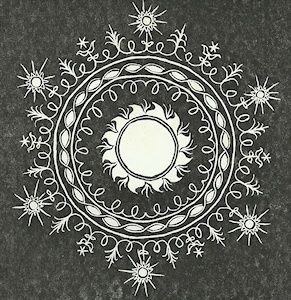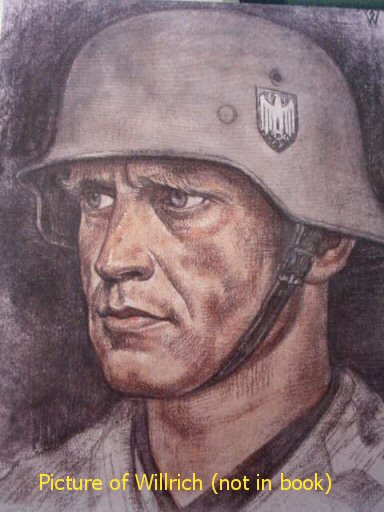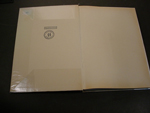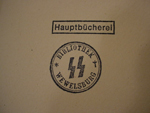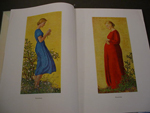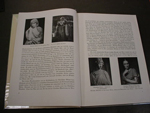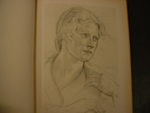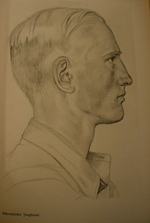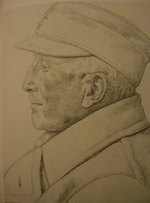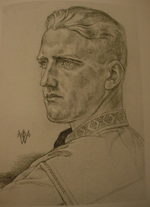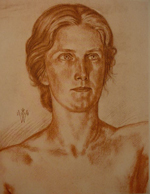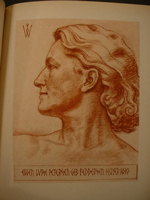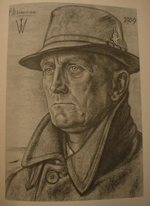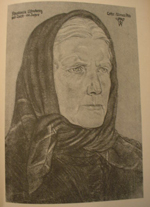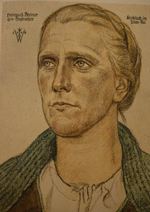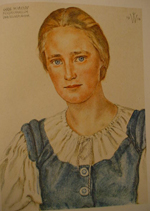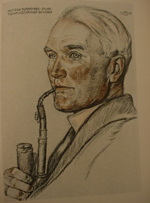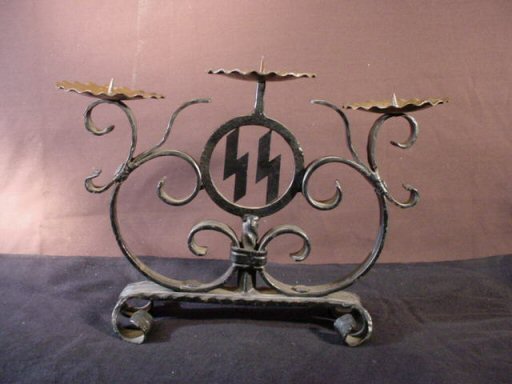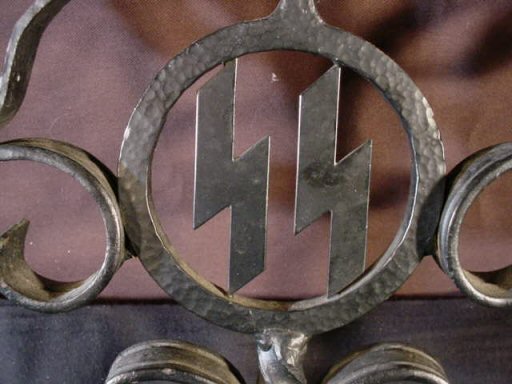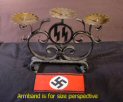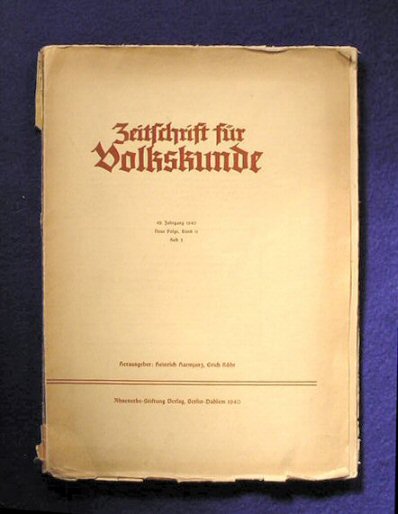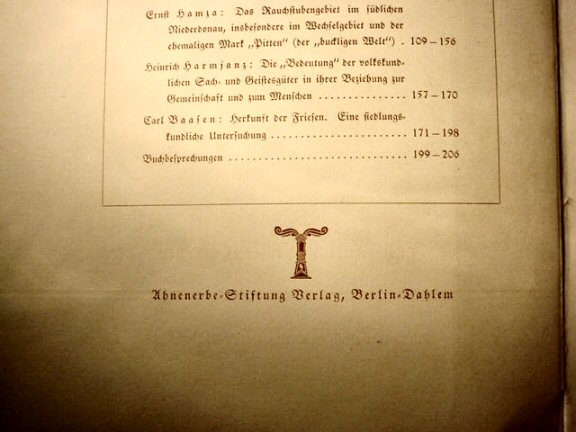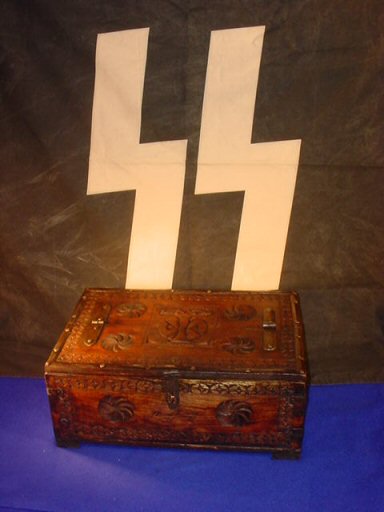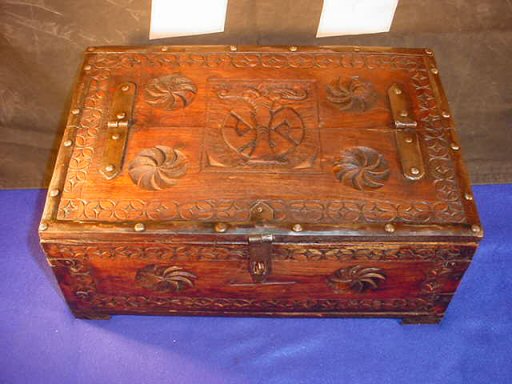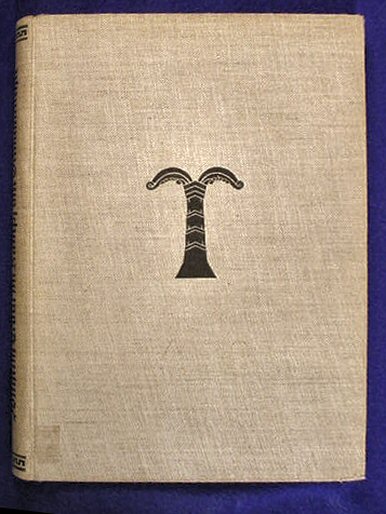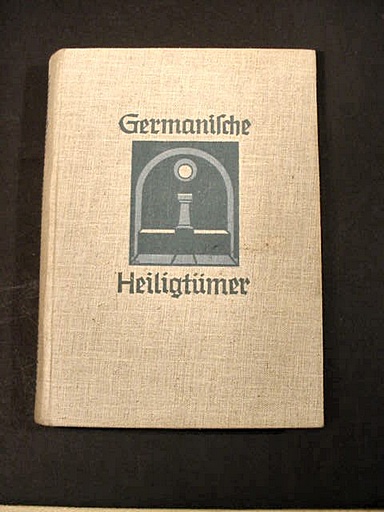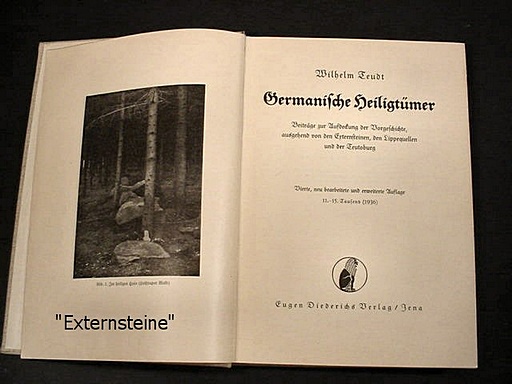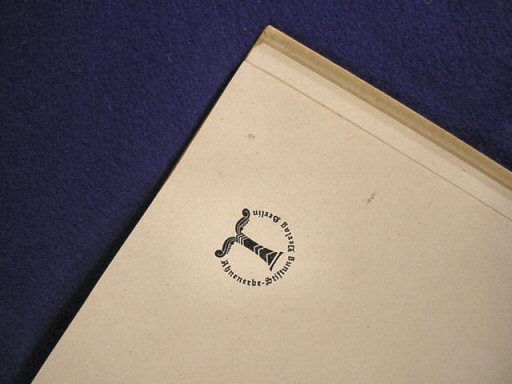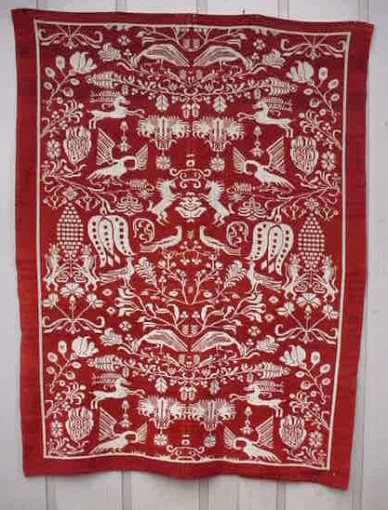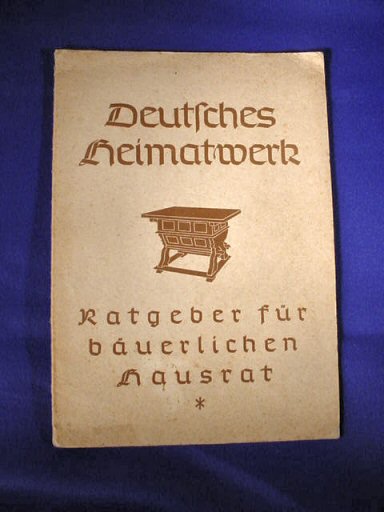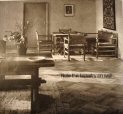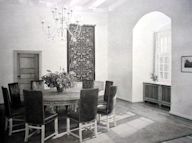|
|
|
|
Deutches Ahnenerbe
Page 3
|
|
|
||||||||||||
|
Book Wolfgang Willrich, Des Edlen Ewiges Reich, The Nobility of the Eternal Reich (Item AHN 3-1; ART 10-4) |
||||||||||||
| DESCRIPTION: When we speak of nobility, here it is before the eyes of the reader. Willrich said it best in his depictions of the German Volk in all their Aryan beauty. In no era in history was Schöenheit beauty more revered by artists such as Sepp Hilz, Thorak, Richard Klein, Brecker, and our Wolf Willrich. This grand work has 40 pages of text mixed with pictures of Germanic women through the ages. And then 48 pictures in full-page presentation of German young and old from all walks of endeavor; from all the sections of the German Fatherland. The decency, the resolve, the intellectual countenance, and, yes, the nobility shows in each face. No pot smokers, no shirkers, no one in need of a therapist, no hussies, no Cola-Cola culturists; just the faces of Teutonics in all the glory of the species. The book was printed in 1941 by the Grenze und Ausland Verlag in Berlin. On the opening page is the Irminsul as used by the Deutsche Ahnenerbe as its logo. This publisher was a subsidiary of the Heritage Foundation, the section for racial study. In some of the pictures runic letters are employed with the name of the person depicted and the section of Germany he or she represents. The cover of the book is quite distressed unfortunately, with damage to the spine (but holding). The dustcover was gone, but the front part of it is glued in the inside front page within. The pages and pictures are all in perfect shape; however, and the book is considered extremely rare and is a prodigiously important archival treasure for the historian of the Third Reich. It measures 11 x 8 inches and is 1/2 inch thick.
PRICE: $395.00; very reasonable |
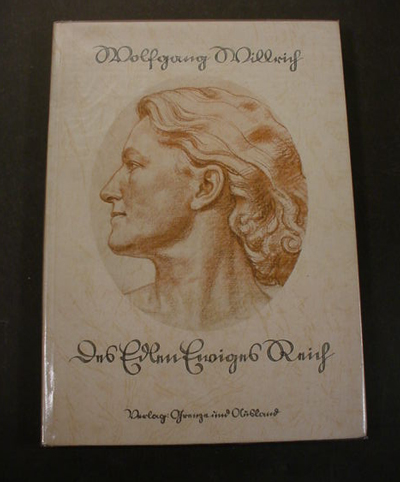 |
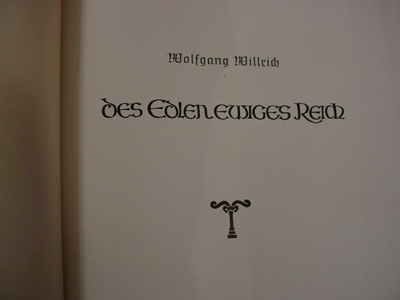 |
Book by Wolf Willrich Des Edlen Ewiges Reich (The Noble & Eternal Reich) Ahnenerbe Edition (Iem AHN 3-2A & ART 11-5A) |
DESCRIPTION: This is the later edition of the book found above at Ahnenerbe 3-1 except it is a later edition from 1943 the book was so popular that it was published from 1938 to 1943. See our description in AHN 3-1. One of the most beautiful and historically important books of the 3rd Reich almost the ’Grail book” of Germanophiles such as myself (I have my own treasured copy). This edition has a different cover with the profile of a Nordic beauty gracing it like a noble Aryan Goddess of old. This volume is in near mint condition and its rarity is further edified by the fact that it is one of the books from the SS Leadership Schools at Burg- Wewelsburg. Go to our Wewelsburg section for more information about this castle and its deep meaning to the SS and Reichsführer SS Heinrich Himmler. These books are extremely rare and most of them were destroyed by the “culture distorters” after the war and it was their mission to make the Scared Fatherland into a nation embracing the worst of the American “Coca-Cola culture”. It is very fortunate that we are able to offer you this wonderful volume and even more pertinent and propitious is the fact that it formally was in the library of the Deutsches SS Ahnenerbe library at the castle. The stamp with the words ‘Bibliothek Wewelsburg’ in a circle are found inside the front cover. Just about this is a long rectangular configuration with the word Haüptbucherei. This means the main library. The book measures 8 x 11 and it has a plastic dust cover that has served over the later years to preserve it in the great shape it is in. PRICE: $345.00 |
|
|||||||||
|
SS Candle Holder in Iron (Item AHN 3-2; SS 24-9) |
|||||||||
| DESCRIPTION: Here is one of the items that most personifies the spirit of the SS organization and the ceremonies conducted within the inner sanctum of the Black Corps. This is a wrought-iron candle holder, probably fashioned by hand in a blacksmith’s shop in the special section of the Ahnenerbe. There was a whole section of the Ancestral Heritage Organization that concerned itself with re-creating relics of the past as well as designing articles that by their very nature and fashion would be typical and important to the mythos of the SS. Here we see a prime example of this tradition. The design is 100-percent SS in every aspect; even to the iron that it is fashioned in iron-like oak typifying the iron will, the iron determination. Iron was as oak; almost a holy word among the Teutons from early times. Thus we have the Iron Cross, the “Iron Chancellor” Bismarck, the Iron Crown, and the weapons of the Alte Germanin were of iron. This is a candle holder that typifies the “Iron Dream.” Many art pieces of iron were produced in the Third Reich by SS, HJ, and RAD. Eagles, organizational plaques, gates, window hangings, and re-creations of Teutonic daggers and swords were made of iron. This is, however, the best we have seen for artistic style—simple, yet meaningful. The entire piece is produced in iron except for the sculpted candle-wax receptacles and they are of brass. This is a rare relic of the Schutzstaffel. It measures 11 inches from bottom to the highest point and is 17 inches across.
PRICE: SOLD |
|
|||||||||||
|
Publication of the Ahnenerbe, Zeitschrift für Volkskunde, Periodical for Folklore (Item AHN 3-4) |
|||||||||||
| DESCRIPTION: This is an advanced scientific publication of the Ahnenerbe Stiftung Verlag Berlin-Dahlem. It came out of the library of the Braunschweig Institute of Higher Learning and Culture and is marked and numbered within 206 pages of text and 20 photos of archeological exploration. In the back is a stamp from the office of the Reichsführer-SS Reichsicherheitshauptamt, or security section. The book is full of maps and diagrams chronicling ancient times and the intensive study therein by this the greatest academic study group of all ages. It was published by the Ahnenerbe in 1940 and has the Irminsul logo inside the front cover. Ancestral heritage books by this organization are very rare and sought after.
PRICE: $250.00 |
|
|||||||
|
Carved Chest from the Deutsches |
|||||||
| DESCRIPTION: Here is a great handmade and hand-carved chest from the Deutsches Ahnenerbe (the Ancestral Heritage Research and Teaching Society or Ahnenerbe Forshungs und Lehrgemeinschaft. This academic group was funded in July 1935 by Reichsführer Heinrich Himmler as a registered club and nonprofit organization. Hermann Wirth, (a Dutch historian), and Richard Walter Darré, creator of the NS blood-and-soil ideology, were the original co-creators of this fantastic scientific group. Later in 1935, Obersturmmführer-SS Wolfram Sievers was appointed Reichsgeschafsführer, or Reich manager, of the organization. He rose to the rank of SS-Standartenführer by the end of the war. It has been said that the Ahnenerbe was part of Himmler’s greater plan for the creation of a Germanic culture that would replace Christianity in Germany after the war. Rather, it was a politically motivated academic association that was completely open minded in its research which included delving into the true meaning of Christianity and through intensive study even divorcing Christianity from its Semitic overtones and much was said about the fact that the biblical people were not in fact Jews as we know them today. At the same time they rejected the occult theories of groups such as the Thule Geselschaft. A central function of the Ahnenerbe was the publication of materials as part of the effort to investigate and revive Germanic traditions. The organization had fifty different research branches called “institutes,” which carried out more than 100 extensive research projects such as Tibetan research and archeological expeditions, linguistic study, especially the ancient language of the Nordic and Aryan peoples and their runes. The organization also was extremely instrumental in promoting the arts, especially the arts that depicted Germanic subjects derived from the “Alte” Germanic past. Hitler Youth children were taught in Ahnenerbe-sponsored classrooms the art of carving and creating articles that were reminiscent of the Germanic culture groups and eras. We believe this highly carved chest was definitely constructed under Ahnenerbe influence and possible tutoring. It has the Irminsul symbol with swastika in the sun-wheel pattern as its central theme. This “Sonnerad und Hakenkreuz” design was the symbol most closely identified with this ancestral heritage group. All around the sides of the chest are runic symbols. The chest’s latch and hinges are of hand-wrought iron. The opening of the lid is “different” in that only 1/2 the lid lifts—why? The ironwork also completely frames the lid and top, as well. All over the sides, top back are other sun symbols with the ever-turning rays, while the edges all around have diamond-shaped star design as borders. It’s Ahnenerbe all the way and a very important piece of Germanic culture. It is big; it measures 14 1/2 x 9 1/2 inches across the lid, is 6 inches deep, and 9 1/2 inches wide. This is a great museum-quality relic of the greatest organized academic study group the world has ever seen.
PRICE: SOLD |
|
|||||||
|
Ahnenerbe Publication by Dr. Prof. Wilhelm Teudt (Item AHN 3-6) |
|||||||
| DESCRIPTION: In Kampf um Germanenehre, In Battle for German Honor was written by the greatest of the archeological academics in Germany, Dr. Prof. Wilhelm Teudt, and is a great study of some of his most important works. For more about the professor and the mission of the Ahnenerbe go to. SS-Ahnenerbe Ring, Item AHN 1-1. This book is hard linen cover measuring 7 x 9 1/4 inches with the Irminsul, sacred tree of the ancient Saxons, on the cover. This was also the logo of the Deutsches Ahnenerbe Stiftung, the Office of Ancestral Heritage and the book was published by the Verlag von Delhager & Klasing in Bielefeld in 1940. This company had Ahnenerbe approval and connections. The book has 215 pages mostly text and maps and hand drawings interspersed. At the end there are seven pages of photos of vastly important German archeological sites and ancient carvings in stone. Prof. Wilhelm Teudt was called the “Extersteineführer,” the world’s authority on the Saxon worship holy place known in English as the Rocks of the Sun. This group of rock formations near Paderborn, Germany, erupts from the ground with no other such formation or natural rocks anywhere in the entire area that is essentially flat. The only closeness to explanation is found in Prof. Teudt’s exhaustive studies. At the top of the highest rock formation is the place where the sacred Irminsul once stood built some say by the hands of the sun worshippers while some say it was a natural formation. It was destroyed by the Germanic Charlemagne (Karl der Grosse) in the first act in the Diet of Worms in 772. The Externsteine is located in the historically famous Teutoburger Wald (the name means stones of the egge). It was clearly the center for religious activity for the Teutonic peoples and their unknown predecessors prior to the arrival of Christianity in northern Europe. Paleolithic and Mesolithic stone tools were found there dating before 10,000 B.C. In 1093, the land surrounding the stones was bought by the monks of the Abdinghof of Paderborn. Traces of human activity including Externsteine, rock carvings of Christian images, date from this period. In the 1920s, Prof. Teudt joined the NSDAP (Nazi Party) and proposed to turn the place of the rocks into a sacred grove for the commemoration of the ancestors. Heinrich Himmler was open to the idea and in 1933 initiated and then provided over the Externsteine foundation headed up by SS-Standartenführer Wolfram Sievers. Interest in the location was furthered by the SS-Ahnenerbe which did intensive studies of the stones for their value to Germanic folklore and history. Some neopagans and Germanophiles continue to believe that the Irminsul was located as we have briefly mentioned at the Externsteine and identify a “bent tree” depicted beneath the cross in a 12th-century Christian carving with it. The site has also been of keen interest to various worldwide nationalist movements and continues to be a frequently visited point of interest to such as (we!) There is much information to be had by going to Google and typing in ‘externsteine.’ Note: In the pictures of the crucifixion carved in rock you can see the Irminsul bent over with a figure noted to be Joseph of Armenthia then seemingly standing on the Saxon-venerated object, but Joseph’s legs do not reach the Irminsul. The theory is that Saxons came in the night in the ancient times and carved Joseph’s offending legs and feet (true?). Also, take note of the picture of the sun altar that is found in the sun chamber in the middle rock formation. It was here where the sun’s rays light up the altar when shining through the circular hole that the priests would shout to the large assemblage below “Siege light, heil light,” and the summer solstice rites would officially begin (been there, done that). This is an ultrarare and important NS-culture book and should be carefully preserved in an important collection.
PRICE: $495.00; exceptionally rare! |
|
||||||||||||
|
Book Germanische Heiligtümer, Germanic Sanctuary, a Study into Germanic Holy Places (Item AHN 3-6a) |
||||||||||||
| DESCRIPTION: This book is by Wilhelm Teudt. See the book above. These were from an Ahnenerbe-connected publishing house. This book is sort of a follow-up or continuation of the book at AHN 3-6 above. It explores ancient Germanic tribes and their places of holy veneration such as the Externesteine in the Teutoberger Wald. Please read about Professor Teudt in Kampf um Germanenehre. This volume is composed of 379 pages with a foldout map in the back. There are many pictures of the sites, relics, and places that were so sacred to the early Germanic peoples and of course also sacred to the SS-Ahnenerbe, as well. Professor Teudt was called the “Externesteineführer,” and no man knew more about the German past, glories, and fascinating history. The book measures about 7 x 10 inches and is in very fine condition with a gray, linen cover. It has an ex libris card pasted in the front with eagle-snake design with the words “Mein Eigen,” “my property.” These bookplates or ownership cards are often seen in Third Reich books. They were distributed by the Franz Ehr Verlag, the official NSDAP printing office.
PRICE: $250.00 |
|
||||||||||||
|
Book Wolfgang Willrich, Des Edlen Ewiges Reich, The Nobility of the Eternal Reich (Item AHN 3-7) |
||||||||||||
| DESCRIPTION: This is a really great Ahnenerbe publication by Siegfried Lehmann published by the Ahnenerbe Stiftung Verlag in Berlin-Dahlem. It’s a 90-page book with text and many illustrations and photography that depict ancient symbolism, jewelry, gravesites, wooden carvings, tapestries, ritual embellishments, and objects of ancient veneration, pottery, etc.; all with deep historical meaning. For further explanation of SS-Ahnenerbe and its academic agendas go to Item AHN 1-1. This hard-bound book measures 7 x 10 inches and is in very fine condition and can be considered extremely rare. Ahnenerbe items are wonderful investments because they will be considered treasures in the near future because the world now realizes that this was the premier institute for the study of ancient cultures that has ever existed.
PRICE: SOLD |
|
||||||||||||||||||||||||||||||||
|
NS Volkskunst Wandteppich, National Socialist-inspired Tapestry (Item AHN 3-8; ART 13-2) |
||||||||||||||||||||||||||||||||
| DESCRIPTION: The NS Kunst Bewegung, or art movement, was from its inception looking for a new art form with the spirit of the ancient values and traditions. One of the artistic phenomena that evolved was “ Volkskunst,” or folk art, and it derived from the classic and beautiful art expressions of the early Germanium, especially the Teutons and the ancient Saxons. The tapestry that we offer here is the typical wall hanging as promoted by the NS Bauerlichenhausen, or farmer’s house. Farming and other agricultural pursuits were encouraged and rewarded in the Third Reich. There was a vast back-to-the-land program sponsored by SS-Obersturmführer Walter Darré. Included in this program was schooling in the Bauerenkunst, or typical ancient art as expressed in the farm communities of the old Reich. Of course the Deutsches Ahnenerbe or Office of Ancestral Heritage had a hand in this, as well. It sponsored with Darré an inner-party program and educational foundation known as the Deutsches Heimatwerk. This was an academic study group that researched and taught the arts of this particular nature, but its main input was the promotion of the resurgence of Volkskunst to modern-day beautification and application to the home of citizen farmers. Students were taught to create such items as pottery, ironwork, wood carvings, and woven items such as, and most importantly, tapestries. The tapestry was considered almost a sacred thing to the ancients and to the NS mythos. The Norms of Germanic saga weaved the destiny of man while seated under the Heilegebaum, the oak tree, the holy tree of Germanic culture. We include pictures from the special publication Deutsches Heimatwerk, the official Bauerlichen guidebook. In this book are plans, photos, descriptions that demonstrate the style of the approved Bauerinmobile, farm furniture, and trappings for the NS farmstead. In these pictures you will see a tapestry much like the one we offer hanging on the wall of an approved “Gutezimmer” (excellently laid out room). You will also see that this artistic expression with the mythological animals appears also on chair upholstery. IN an article from another NS magazine for women called Saxon Volkskunst, you can see a couple of embroideries employing again these flora and animal scenes so prevalent in this exclusive NS art form and in the Ahnenerbe publication by Siegfried Lehman, Deutsche Volkskunst. More of such items are shown with this theme. You can also go to our Ahnenerbe chest to be seen at Item AHN 3-5 and compare some of the woodwork as shown in this book published in 1943 by the Ahnenerbe Stiftung Verlag Berlin-Dahlem. The importance of tapestries cannot be underestimated in the NS Reich and this is a very important one. In the Reich’s Chancery there were several that were almost identical in design to this one. The size of this amazing art piece is 53 inches by 6 feet! The tapestry was done in two parts and expertly joined in the middle as many of the important ones were accomplished. The condition is excellent and the colors are brilliant. The pattern is really beautiful and it speaks volumes about the NS artistic expression as hardly anything else could. We are very proud to present this great historical item to the collecting and museum world.
PRICE: SOLD |
|
Group of Letters from SS-Ahnenerbe’s Main Office in Berlin (Item AHN 3-9) |
| DESCRIPTION:
This is an exchange of letters between the Ahnnerbe director, or Reichsgeschäftsführer and SS-Obersturmbahnführer, Wolfram Sievers, and a professor at Heidelburg University. Letter number one: January 17, 1942 from Sievers Letter number two: February 17, 1942 from Ahnenerbe Letter number three: February 24, 1942 from Fehrle Letter number four: February 28, 1942 from Ahnenerbe Letter number five: March 31, 1942 from Ahnenerbe PRICE: SOLD |
|
|
||||||
|
Letter Number One; A Letter of Thanks to a Professor Dr. Fehrle |
||||||
| DESCRIPTION: The letters begin with a letter of thanks to a Professor Dr. Fehrle at the Heidelberg University. It is typewritten, and signed by SS-Obersturmbannführer Wolfram Sievers, who always signed his name with the first and last letters employing the ‘S’ rune. In the letter he informs the professor that the Swedish rock engraving that the university ordered is now ready and he is pleased to announce this result “…and that we were able to supply it.” He then signs it under the greeting Heil Hitler. This is a great Ahnenerbe letter because it touches on the great services of this academic group to the colleagues and museums throughout Europe. This brilliant and studious man, Sievers, was executed at Nuremberg by his intellectual inferiors. |
|
|
||||
|
Letter Number Two; Answer to Your Letter of Jan 23 |
||||
| DESCRIPTION: This is a follow-up from a subordinate for the Reichsgeschäftsführer Sievers to Professor Dr Fehrle “… that the loading and transportation of the rock paintings is very difficult. We have to inform you that the transportation boxes will cost about 70 Reichsmark each. We cannot accept a return of these boxes because they are unsuitable for transportation of any other items. On top of this is the cost of fetching the cast and transporting them to a suitable depot, packing material, and transport to the RR station and other expenses of an extra 29 RM. Then are the transport expense of 8.40 RM per 100 kilograms, plus insurance cost of 5 percent of the value. We are waiting your response to our above-mentioned costs and your acceptance of the same. i.A. (on behalf of).” This of course bears all the official headings of the Deutsche-Ahnenerbe. |
|
|
|||
|
Letter Number Three; Letter from Dr. Professor Fehrle to the Attention of the Reichsgeschäftsführer of the Ahnenerbe in Berlin-Dahlem |
|||
| DESCRIPTION: This letter is dated February 24, 1942 and the professor basically says: “I should hereby thank you for your letter of February 17, 1942 regarding the transportation of the rock castings. We realize that the whole packing and transportation is not cheap, but we definitely would like you to go ahead with this issue. I will personally pay the expenses, preferably before April for reasons of taxation. Can you send me a total invoice (2 copies), even if the transportation cost is more and not known to you yet? Heil Hitler.” He does not sign the letter. |
|
|
|||
|
Letter Number Four; Letter on official Ahnenerbe Stationary |
|||
| DESCRIPTION: This letter is on official Ahnenerbe stationary of the Schnellbrief type dated February 28, 1942, to Professor Dr. E. Fehrle at the University of Heidelberg in reply to letter dated February 24, regarding casts of rock painting. “In reply to your above-dated letter, we can inform you that your wishes have been accepted. The casts have been handed over to a Haulage company and they have given us confirmation and assurance that the consignment will be in Heidelberg before the end of March. We will mail you the invoice in good time. Heil Hitler!” The letter is signed for Sievers by an SS-Untersturmführer. |
|
|
|||||||||
|
Letter Number Five; Another Letter signed on Behalf of Sievers |
|||||||||
| DESCRIPTION: The is another letter on behalf of the Reichsgeschäftsführer Sievers signed by the same SS-Untersturmführer to Professor Dr. E. Fehrle at Heidelberg University dated March 31, 1942. “Professor Dr., In reply to your original letter of January 23, 1942, concerning the cases of the Swedish paintings, we can now confirm that the casts have been given over to the haulage contractor, who will deliver these items to the Reichsbahn (RR) for transportation to Heidelberg. Because of difficult circumstances it might take a bit longer than what we anticipated for these to arrive. The invoices are with the consignment and we would like the full amount to be paid to our official account #920-01 AMT, post check Berlin” This group of letters in this exchange is certainly very rare, especially with Wolfram Sievers’ signature on the first one. The letters have been preserved well and are in beautiful condition with a crease, a slight stain (mostly at edges). The first one from Sievers himself is in great condition. |
Page Three |
Please refer to item designator in parentheses in all correspondence.
Please E-mail for any additional information you may need.If you prefer, contact 'Germania' at PO Box 68, Lakemont, GA 30552
or call at 706.782.1668.
Please! do not call during the wee hours of the morning. The best time for calling us is between 10 am and 12 noon and between 9 and 11 pm eastern time.


